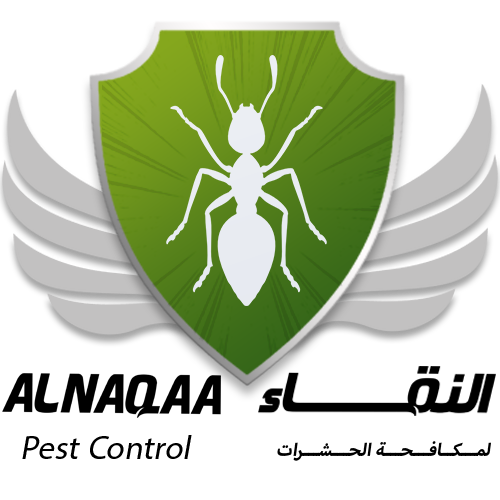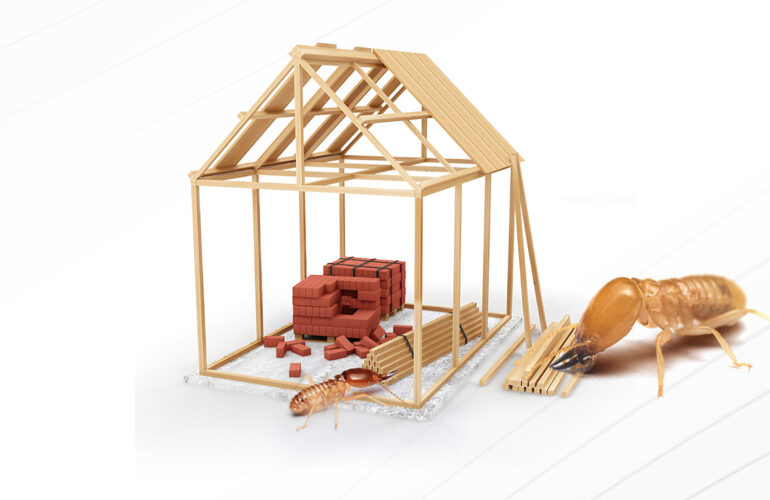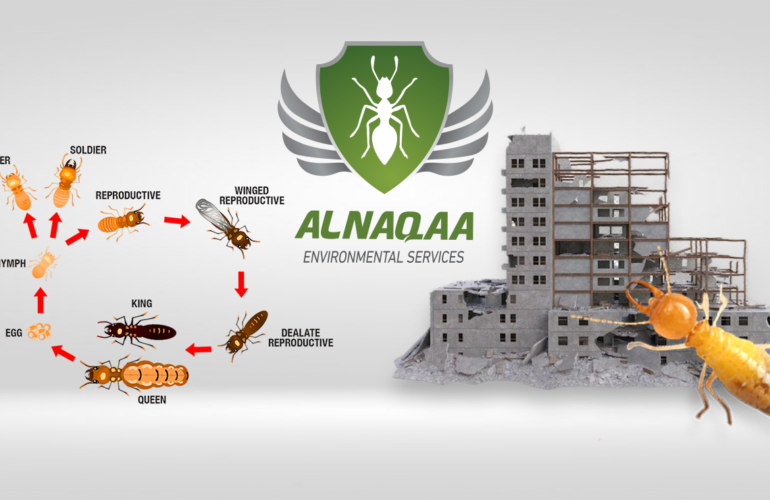What is a Termite?
Termites are small insects that feed on wood and cellulose, causing serious danger to houses and structures. If left unchecked, these “silent destroyers” can cause catastrophic structural damage, requiring costly repairs. Effective termite prevention is critical for protecting your home and providing peace of mind. In the following article, we go over some of the most effective termite treatment strategies for protecting your house from these stubborn pests.
Know Your Enemy: Identifying Termite Species for Effective Control Strategies
It is critical to identify the termite species infesting your property before adopting a pest control approach. Subterranean, dry wood, and damp wood termites are the three most frequent forms of termites. Each species has distinct characteristics that require specific handling methods. Consult our certified termite inspectors at ALNAQAA Environmental Services to properly determine the termite type and evaluate the severity of the infestation.
Indications of termite infestation
1-Mud tubes: Termites construct mud tubes to serve as protective passageways between their colony and food sources. These tubes are commonly seen along walls, buildings and other surfaces and are generally formed of dirt, wood parts, and saliva.
2-Swarming termites: Throughout the breeding period, reproductive termites (ALATES) swarm from their nests to build new colonies. A swarm of flying insects (often with wings) near your home might indicate an outbreak of termites.
3-Discarded wings: Termites lose their wings after swarming in order to mate and choose a nesting place. Termites can be spotted by finding piles of abandoned wings near doors, windows, or other access places.
4-Hollow-sounding wood: Knock on wooden surfaces that you worry are termite-infested. If the wood feels hollow or papery, this might indicate that termites have eaten what’s inside.
5-Bubbling or peeling paint: As termites feed on wood, they release moisture, causing paint on wooden surfaces to bubble or peel.
6-Tight-fitting doors and windows: Termites may make doors and windows difficult to open and close as they eat their wood.
7-Termite droppings or frass: Termite droppings, also known as frass, are small, pellet-like droppings that termites discharge from their tunnels. Having any of them near termite access spots may indicate an infestation.
8-Damaged or sagging floors: In severe infestations, termites can weaken hardwood floors, forcing them to collapse or become uneven.
9-Visible mud or dirt in construction joints: Termites frequently enter structures through cracks and gaps in construction joints. In these places, look for mud or dirt formation.
10-Wooden tunnels: Small tunnels or passages in wooden constructions may indicate the presence of termites.
If you suspect termite infestations inside your home or property, contact us at ALNAQAA Environmental Services immediately for a comprehensive examination and treatment. Early discovery and control can help prevent serious termite damage.
Defending Your Property: Exploring Effective Termite Treatment Strategies
The numerous procedures and strategies used to deal with or get rid of termite infestations in houses, buildings, and other structures are referred to as termite treatment in pest control. As we already knew that termites are wood-eating insects that may cause severe damage if left untreated. As a result, it’s critical to put in place efficient termite treatment techniques to safeguard your home from potential damage.
Our pest control specialists at ALNAQAA mostly utilize the following termite treatment options:
1-Chemical Barrier Treatment: To form a barrier, liquid termiticides are applied around the outer edges of the building’s base or straight into the soil. Termites in the loop with the treated soil are either defeated or eliminated, preventing them from entering the structure.
2-Baiting Systems: Baiting systems employ termite baits carefully distributed throughout the property. These baits include termite-attractive chemicals and are slow-acting, allowing termites to take the bait back to their colony and finally eliminate the entire colony.
3-Wood Treatments: To kill termites and prevent further infestations, infested wood can be treated with specific termiticides or insecticides.
4-Fumigation: Fumigation may be required in extreme infestations. This entails tenting the entire structure and releasing a gaseous pesticide that penetrates the wood and kills any termites that may be there.
5-Physical Barriers: To restrict termite access, physical barriers can be established during construction. Stainless steel mesh or termite-resistant construction materials are examples.
6-Monitoring and Inspection: Regular inspections by pest control specialists aid in the early detection of termite activity, enabling for prompt treatment and prevention.
It is critical to contact a licensed and proficient pest control company to examine your home thoroughly to determine the best plan of action for termite treatment. Furthermore, taking preventive steps such as decreasing moisture surrounding the property, keeping wood away from the soil, and repairing any leaks or water damage will help lessen the chance of future termite infestations.
Effective Strategies for Termite Control and Prevention
Termiticide Application for the Soil
Soil spraying with termiticides is a common strategy for controlling subterranean termites. Termiticides are chemicals that are used to either fight or kill termites. These chemicals are applied to the soil surrounding the structure, forming a barrier that prevents termites from accessing the soil beneath the structure. Bait stations can be properly positioned to attract and kill termite populations.
Chemicals for Wood
Various wood remedies can be used to protect wooden structures from termite infestations. These treatments involve the application of borate-based solutions to the wood, which are poisonous to termites but not to people or animals. The treated wood works as a barrier to termites, stopping them from feeding on or tunneling through it.
Dry wood Termite Fumigation
Dry wood termites are known for infesting wooden furniture, walls, and other buildings. Fumigation is an effective treatment for severe dry wood termite infestations. Fumigation entails isolating the contaminated area and injecting a gas into the wood, killing the termites inside. This approach provides complete pest elimination within the treated area.
Physical Barriers and Construction Modifications
Preventing termites from entering your property in the first place is critical. Physical barriers such as metal mesh and sand barriers surrounding the foundation can help keep termites out of the structure. Furthermore, structural changes such as efficient drainage systems and ventilation can lower moisture levels, making the atmosphere less appealing to termites.
Regular Inspections and Maintenance
Regular checkups are critical for detecting termite activity immediately. Inspecting your home on a regular basis for indicators of termites, such as mud tubes, abandoned wings, or hollow-sounding wood, might help you act quickly. Early action can save money on termite control procedures and avoid serious damage.
A proactive strategy is required to protect your house against termite infestations. You can protect your home from these damaging pests by combining preventive measures with our expert termite control solutions. Remember that working with expert pest control specialists is important to create a customized termite control strategy that is tailored to your individual scenario. You may be confident that your property is well-protected against the ever-present threat of termites if you implement the proper techniques.





